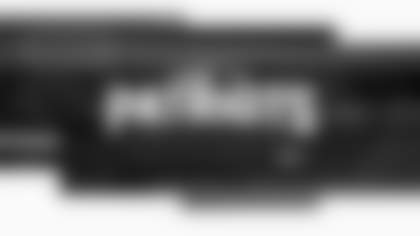The Patriots roll into Week 2 on a high following their victory over the Bengals last Sunday in Cincinnati, the biggest upset in the NFL in Week 1.
However, the work has just begun for head coach Jerod Mayo's squad. As satisfying as it was to see Mayo win his debut as Patriots head coach, it's time to turn the page to Sunday's home-opener against the Seattle Seahawks at Gillette Stadium.
When his promotion was made official in January, Coach Mayo was the youngest head coach in the NFL (age 37), but he was unseated by new Seahawks coach Mike Macdonald a few weeks later. Macdonald is a year and four months younger than Mayo, taking over for Pete Carroll after stints as the defensive coordinator in Baltimore and at the University of Michigan. As the two youngest coaches in the NFL this season, Macdonald and Mayo both won their first games as head coaches.
New England began laying the foundation for how it wants to win games in Week 1, with an outstanding defense performance supplemented by a ball-control offense led by a strong rushing attack and solid game-managing from veteran quarterback Jacoby Brissett. It was a great road win, but now it's time to discuss replicating their success vs. Seattle.
Starting with the offense, there are a few areas where the Patriots must improve. Mainly, New England won't win many games where Brissett throws for 121 passing yards on +0.05 expected points added per drop-back (46th percentile). Over the last two seasons, there were 32 instances where a quarterback threw for under 125 yards on 20-plus pass attempts, and those teams went 8-24, so Brissett winning with those stats is abnormal.
At this stage of his career, the nine-year veteran isn't going to magically morph into an aggressive downfield passer willing to test NFL-sized passing windows to hunt big plays. That's not Brissett's game, which is fine when the game script goes as it did in Week 1. The question is can Brissett and the passing offense do more because, eventually, the Patriots will need more than 16 points to win.
Since we're not expecting Brissett to morph into a big-time playmaker suddenly, the offensive line must do a better job in pass protection to give the 31-year-old veteran time to go through his progressions to find open receivers downfield. In Week 1, the Pats allowed a league-high 48.3% pressure rate while ranking 28th in pass-blocking win rate. The main pressure points were at left tackle (six combined pressures, two QB hits) and allowing free runners.
The Patriots options at left tackle are what they are right now. They're not magically going to acquire Matt Light in his prime to block Brissett's blindside. Hopefully, a full practice week for Vederian Lowe, who played most of the game at left tackle after replacing starter Chuks Okorafor, will make for a smoother ride. However, the free runners with pass-rushers coming through the line unblocked need to be corrected.
According to NextGen Stats, the Patriots allowed four unblocked pressures vs. the Bengals, with the third-highest unblocked pressure rate in the NFL's opening week (13.8%). Cincinnati defensive coordinator Lou Anarumo caused assignment issues in the Pats pass protection by using creeper schemes, where the defense forms a four-man rush by adding a rusher the defense isn't expecting to blitz and subtracting one they have accounted for on the line of scrimmage. Using these schemes allows the defense to maintain a seven-man coverage structure while still confusing the offensive line.
For example, the Bengals got multiple pressures from their 5-1 odd front using this creeper scheme. The offensive line is completely covered with five rushers players on the line of scrimmage. At the snap, the EDGEs drop out into the coverage distribution while the off-ball linebacker adds into the rush. The rushers dropping off the line of scrimmage become help defenders in the man coverage scheme. At the same time, the line anticipates blocking the players on the line of scrimmage, so nobody takes the linebacker blitzing up the middle.
The pick-wheel route concept at the top of the screen causes a collision between the Bengals man coverage defenders, creating separation for WR Pop Douglas. Douglas is open for a big play along the right sideline, but Brissett can't throw accurately under immediate pressure.
This week, these mental errors along the offensive line could be exacerbated by Macdonald's exotic pressure system, which was the darling of the NFL when he coordinated the Ravens defense. Macdonald got a head coaching gig following a season in which Baltimore ranked first in DVOA on defense by using all sorts of fancy tricks to pressure the quarterback.
The Seahawks head coach learned these exotics from former Ravens assistant Wink Martindale, who is known for having some of the best pressure systems in football. Last season, Baltimore was top-six in creeper pressure rate (5.1%) and simulated pressure usage (1.5%), leading to a ninth-place finish in overall team pressure rate (38.7%).
Now, Macdonald is bringing his pressure system to Seattle, where the Seahawks logged the second-highest pressure rate in Week 1, and led the NFL in defense DVOA. Broncos QB Bo Nix was pressured on 43.1% of his drop-backs, threw two interceptions, and produced the lowest total EPA in his NFL debut last Sunday (-23.0). Seattle's defense also was tied for second by creating five unblocked pressures in the win over Denver, so that's a major issue they'll present for the Patriots.
"Everyone is a threat," head coach Jerod Mayo said on Wednesday. "When we talk about known rushers, it's really the unknown rushers that make that Baltimore defense special. You don't know who's coming. They drop out defensive ends. They do things that are very similar to some of the things that we do as well, the zone blitzing and protecting the deep part of the field."
In 2022, Macdonald's defense sacked the quarterback five times in a 23-20 win for the Ravens over Brissett and Patriots offensive coordinator Alex Van Pelt's Browns. Typically, Macdonald plays zone coverage behind these pressures, with Seattle playing zone coverage on 77.6% of the Broncos drop-backs in Week 1. In 2022, Baltimore played zone on 70.6% of the Browns drop-backs vs. Brisset and AVP.
Above, Baltimore uses a creeper pressure similar to the one Cincy leaned on last week. The Ravens drop their edges into coverage to form a cover-three zone while bringing both off-ball linebackers on a blitz. The interior blitz creates a two-on-one for the running back, where the back can only block one rusher, and Brissett cannot get a pass off in the pocket.
In their win over the Broncos last week, the Seahawks went to Macdonald's simulated pressure package in passing situations. Simulated pressures are when the defense stacks the line of scrimmage like they're going to bring an all-out blitz, but then some of those blitz threats drop into coverage based on the protection. Again, the offensive line has to respect the blitz threats on the line of scrimmage, so the illusion of pressure often creates free runners.
Here, the interior defenders lined up over the center and right guard dropped into coverage, so those two blockers are essentially blocking nobody. The back takes one of the extra rushers coming off the edge, but it's an overload off the left side, and Nix eventually takes a sack.
A Patriots offensive line that remains a work in progress will be tested throughout the game by Seattle's pressure schemes. Macdonald doesn't always wait for third down to bring pressure, either, and he'll likely come after Brissett when New England's quarterback is under-center in situations where the Seahawks head coach anticipates play-action.
From an offensive line standpoint, the general rule of thumb is that the line is responsible for blocking any rushers going through the A and B gaps. So, in that case, the pressure shown above against the Bengals last week was a no-no. As for pressure from outside the tackles, like the Seahawks example vs. the Broncos, those are instances where the quarterback is hot. Nix should know if that rusher who is the furthest threat from the quarterback, which is why it's not the line's responsibility, comes, it's on the quarterback to get the ball out.
Now, offensive coordinator Alex Van Pelt can help Brissett by giving him easily accessible "hot" reads, which Nix did not have in that instance. Plus, if Brissett gets a pre-snap tell that Seattle has a pressure scheme on, he can check into certain things to handle it better.
It's easy to tell the Patriots to avoid these pressure situations by running the ball. Ultimately, however, the offense must execute a drop-back pass game to win games. Savvy defensive play-callers like Anarumo and Macdonald will continue to test their protection plan, so it's on the players and coaches to be buttoned for these exotic schemes on Sunday.
Patriots Defense vs. Seahawks Offense: Will the Pats Concede the Run to Seattle?
The first thing most fans mention when they think about the Seahawks offense is their three-headed monster at wide receiver: DK Metcalf, Tyler Lockett, and Jaxon Smith-Njigba.
Seattle has used high draft picks on Metcalf (second round) and Smith-Njigba (first round), adding them to Lockett in QB Geno Smith's supporting cast. Last season, they ranked sixth in pass DVOA and 12th in total DVOA. If it weren't for a 28th-ranked defense, the Seahawks would've been a playoff team, narrowingly missing the postseason on a tiebreaker at 9-8.
Despite their offense's success, Macdonald didn't retain offensive coordinator Shane Waldron. Instead, Macdonald poached Ryan Grubb from the college ranks to bring a highly successful University of Washington offense to the NFL. Grubb coordinated a Huskies offense with multiple NFL draft picks such as QB Michael Penix, WR Rome Odunze, and, of course, Patriots rookie wideout Ja'Lynn Polk to a national championship game appearance. In the national title game, Grubb's Huskies lost to Macdonald's former employer, Michigan, which might've sparked a mutual admiration between the two rising coaching stars.
When you combine Washington's vertical-based passing system with the Seahawks receivers, one would expect Seattle to be a prolific downfield passing attack. Although that could still come, and there were play calls on film designed to push the ball downfield, Smith surprisingly ranked 16th out of 32 passers in average air yards per attempt in Week 1 (6.7).
Rather than a high-powered passing attack, Grubb's run-game designs caught the eye. Along with shot plays in the passing game, one unique wrinkle in Washington's offense was the heavy usage of pre-snap shifts and motion at the snap. Shifts are when skill players move from one alignment to another before coming to a standstill before the snap, whereas motion at the snap is like jet motion, where the player is moving as the ball is being snapped.
Motion is used to stress a defense's communication while creating blocking angles, numbers advantages, and flipping the strength of the formation. In Grubb's debut as Seattle's play-caller, the Seahawks shifted 10 times for a league-high 17.5% pre-snap shift rate. They also used motion at the snap at the ninth-highest rate (47.4%).
"It puts a lot of stress on us. We're playing at home, so communication is going to be key. Crowd noise and all those things," defensive coordinator DeMarcus Covington told Patriots.com this week. "Then, really it's ID. It's missle motion, shift, going from quarterback under [center] to gun to shift this tight end or going from empty to back home, those things, they do them well. Along with tempo, they do that too and check with me at the line of scrimmage. Communication is going to be one of the keys to victory for us."
Grubb's tactics led to a huge rushing performance against the Broncos, with lead-back Kenneth Walker producing +0.10 EPA per rush with three runs of 10-plus yards and 10 successful runs overall (20 attempts, 103 yards, 5.2 average). Denver's defense was playing primarily out of two-high safety shells because the Broncos were worried about Seattle's pass-catchers. As a result, Walker had 14 carries into light boxes, averaging 6.6 yards per rush on those attempts.
In this clip, Seattle shifts blocking TE AJ Barner and Smith-Njigba before the snap to change the formation's strength. Then, they get Barner started right before the snap to get into a sift block in split-flow zone, where the line blocks outside zone, with Barner kicking out the unblocked defender on the backside. The shift gave the offense numbers to that side of the formation, and Walker has a huge hole to run through.
Here, WR Jake Bobo shifts to create a nub formation, where the in-line tight end is the further player out on the left side of the formation. The motion gets the boundary corner to come into the line of scrimmage, and the linebackers bump over to the offense's right, creating numbers and blocking angles to the weak side so that the pullers can lead the way for a big run.
Lastly, Walker's touchdown run came on a neat scheme called an influence trap. The play design invites the play-side defensive linemen upfield by having the tackle and tight end work immediately up to the second level, creating the blocking angles for the two trap blocks. Once he's up to the second level, Walker has blockers downfield, and he's gone.
During opening weekend, the league averaged 121.5 rushing yards, the highest mark in a Week 1 since 2008. Although offenses deserve credit, game plans aimed at stopping the passing game are also contributing. With the Fangio influence around the NFL, defenses are playing two-high safety structures more often, creating lighter boxes inviting the run.
Offenses are finding creative ways to generate positive plays in the running game to counter these two high defenses. So, it's becoming pick your poison for defenses. Ultimately, most teams will surrender rushing yards over passing yards since the latter is more efficient. If you're facing a dangerous passing offense, by all means, hand the ball off, shorten the game, and keep the score down – that's probably the mindset for the Patriots coaching staff.
This week, the Patriots might catch a break with lead-back Kenneth Walker's oblique injury. Walker suffered the injury during the fourth quarter of Seattle's win in Week 1. If he can't play, top backup Zach Charbonnet will likely get the bulk of the work. Charbonnet caught a 30-yard touchdown on a wheel route last week but wasn't as effective as Walker running the ball, tallying just 12 yards on eight carries.
On Sunday, New England's defensive game plan will probably start with matching up against Seattle's receiver trio, especially if Walker is not available. Grubb will be ready with his run plays: let the chess match begin.
Key Matchups
LT Vederian Lowe vs. Seahawks EDGE Boye Mafe: With all due respect to Lowe, this is your mismatch of the week. Mafe is a twitched-up rusher who can win with speed-to-power and cornering ability. Last week, Mafe logged nine quarterback pressures vs. Denver (sack, QB hit, seven hurries). He also registered a run TFL with a quick-twitch lateral move to avoid a block and explode into the backfield. The third-year pro is a problem.
CB Christian Gonzalez vs. Seahawks WR DK Metcalf: My guess is Gonzo will draw the matchup in man coverage situations on Metcalf, who is just a beast. Metcalf combines ridiculous breakaway speed with physicality to be one of the NFL's premier deep threats. Last week, Broncos star CB Patrick Surtain lined up over Metcalf on 24 routes, holding DK to 29 yards on three catches. However, there were a few missed opportunities for big plays on Metcalf's film. Expect Gonzalez to study Surtain's approach to stick with Metcalf on Sunday.
RG Layden Robinson vs. Seahawks DL Leonard Williams: Another potential mismatch on the offensive line, as Leonard is still very disruptive. Leonard registered five QB hits against the Broncos and even gave stud RG Quinn Meinerz problems. Williams used a double-swipe move to jump inside on Meinerz twice to log pressures. The Pats rookie will have his hands full, as will whoever is playing left guard, likely practice-squad elevation Michael Jordan.
DISCLAIMER: The views and thoughts expressed in this article are those of the writer and don't necessarily reflect those of the organization. Read Full Disclaimer














































